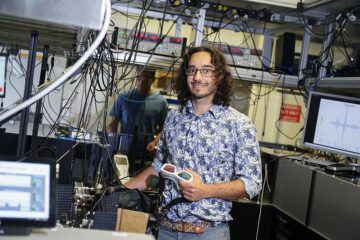Hannover Messe 2013: Switchable adhesion principle enables residue-free gripping in vacuum

During the production process, those parts are transferred in between many process steps. Each pick-up and release with conventional gripping systems involves the risk of either contamination of the surfaces with residues from transportation adhesives, or damaging due to mechanical gripping of such surfaces.
Suction cup systems diminish residues, but fail in a vacuum or on rough surfaces. Researchers at the Leibniz Institute for New Materials (INM) enhanced the Gecko adhesion principle that adhesion can be switched on and off in vacuum.
„Artificially produced microscopic pillars, so-called gecko structures, adhere to various items. By bending these pillars, the adhesion can be switched off. Thus, items can be lifted and quickly released by this bending process,“ explains Elmar Kroner, the deputy head of the program division „Functional Surfaces“. This can be achieved by various mechanisms: Slight shear movements or elevated perpendicular load cause a bending of the pillars without damaging the lifted item. „This technique is particularly interesting in vacuum, as suction cups fail here,“ says Kroner. Parts, for example, can be moved within a reactor chamber for vapor phase deposition (CVD or PVD).
With the currently developed adhesion system, objects with smooth surfaces can be lifted and released, having a weight of approximately 100 gram per square centimeter. „In our test runs, the system has proved successful even after 20,000 runs“, says the materials scientist Kroner. His group is now working on the movement of curved and rough surfaces without leaving residues using this adhesion principle. „Then, we could also move glass lenses or automobile bumpers without damaging them in the production process,“ says Kroner.
From April 8 to 12, 2013, the researchers of INM present this and further results at the Hannover Messe (Hall 2, Booth C40) in the framework of the Leading Trade Fair „Research and Technology“. This includes new developments in the field of display techniques, printed electronics, solar energy, corrosion protection, antifouling, antifriction and functional surfaces.
Contact for this subject at the booth of the trade fair:
Joachim Blau, joachim.blau@inm-gmgh.de
Maurizio Micciché, maurizio.micciche@inm-gmbh.de
Mareike Frensemeier, mareike.frensemeier@inm-gmbh.de
Program Division „Functional Materials“
Contact for this subject at INM:
Dr. Elmar Kroner
Phone: +49681-9300-369
elmar.kroner@inm-gmbh.de
Program Division „Functional Materials“
In addition, INM presents its activities in a broad lecture program at the Hannover Messe:
Tuesday, 09.04.2013, 11:15 a.m., tech transfer – Forum, Hall 2
Dr. Mario Quilitz: „Nanotechnology in the Leibniz Association“
Wednesday, 10.04.2013, 11:40 a.m., Forum „MicroTechnology – Innovations for Industry“, Hall 17
Dr. Mario Quilitz: „Das INM – von der Grundlagenforschung bis zur Pilotfertigung“
Thursday, 11.04.2013, 11:00 a.m., tech transfer – Forum, Hall 2
Dr. Carsten Becker-Willinger: „Multifunktionale Beschichtungen für industrielle Anwendungen“
Dr Peter William de Oliveira: “Optical Material for Displays and Printed Electronics”
INM, situated in Saarbruecken/Germany, is an internationally leading research center for innovative materials. Specialized in the three research fields of Chemical Nanotechnology, Interface Materials and Materials in Biology, the institute provides research and development from molecule to pilot production delivered by a highly skilled team of chemists, physicists, biologists, materials and engineering scientists. It cooperates with national and international institutes and develops materials with tailor-made properties for companies throughout the world. INM is an institute of the Scientific Association Gottfried Wilhelm Leibniz and employs around 190 collaborators.
Media Contact
Alle Nachrichten aus der Kategorie: HANNOVER MESSE
Neueste Beiträge

Neue universelle lichtbasierte Technik zur Kontrolle der Talpolarisation
Ein internationales Forscherteam berichtet in Nature über eine neue Methode, mit der zum ersten Mal die Talpolarisation in zentrosymmetrischen Bulk-Materialien auf eine nicht materialspezifische Weise erreicht wird. Diese „universelle Technik“…

Tumorzellen hebeln das Immunsystem früh aus
Neu entdeckter Mechanismus könnte Krebs-Immuntherapien deutlich verbessern. Tumore verhindern aktiv, dass sich Immunantworten durch sogenannte zytotoxische T-Zellen bilden, die den Krebs bekämpfen könnten. Wie das genau geschieht, beschreiben jetzt erstmals…

Immunzellen in den Startlöchern: „Allzeit bereit“ ist harte Arbeit
Wenn Krankheitserreger in den Körper eindringen, muss das Immunsystem sofort reagieren und eine Infektion verhindern oder eindämmen. Doch wie halten sich unsere Abwehrzellen bereit, wenn kein Angreifer in Sicht ist?…

_670874-85x60.jpg)



















